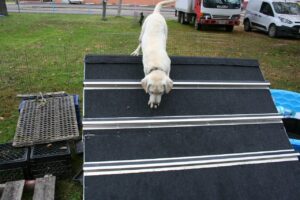
The detection dog capable of working undistracted from its task in any environment is a very rare dog. European vendors selling dogs to the United States government, with many years of experience, often have an acceptance rate under 50%. In a government supported breeding program for detection dogs, the acceptance rate was under 20% for dogs with the lowest amount of selective breeding and with the least amount of purposeful development exercises. The most difficult part for most dog enthusiasts to understand is that these dogs are developed for the singular and independent task of finding odor. This requires dogs with high levels of resilience to perform repetitious and monotonous behavior, motivated and excited to respond to specific odors, and dogs often capable of working independently of the handler. A good dog chooses odor over the handler; a good dog ignores distraction to complete its task; a good dog works past any barriers and impediments to get to the source of odor; and a good dog will perform this behavior at very high search to target object ratios.
Below are attributes critical to a dog’s success in detection work:
Socialization – The dog must be able to overcome the many social interactions required to perform its task. Exercises will be age appropriate.
o Socialization to people – strangers are distractions, not opportunities for rewards
o Indoor behavior and outdoor behavior around people
o People as targets – trained odor may attract the dog, but the dog cannot be intrusive or rude to those people
o Proper behavior in transport
o Proper behavior receiving veterinary care
o Practical bodily elimination
Environmental Stability – Specific exercises that are age appropriate.
o Early neurological development
o Distracting objects and distracting footing
o Noise exposure (noises that are routinely heard in the dog’s potential working environment)
o Negotiating objects and containers that may restrict movement towards odor to include safe heights, extended body reach, elevators, moving walkways, escalators, conveyor belts and carousels
o Becoming neutral to approach/avoidance conflicts
o Distracting odors (cleaning agents, industrial odor, exhausts, food, waste)
Olfactory
o Early development of response to odor as a reward source (self discovery – self reward)
o Learning new odors
o Simple odor finds to complex odor finds
Reward Engagement
o Early development of response to odor as a reward source (self discovery – self reward)
o Exposure to multiple reward items without creating bias
o Types of possession – mental, physical, and independent possession
o Creating extreme desire for possessing beyond the simple retrieve
o Reward from source rather than reward from handler
Search
o How to search in height and depth
o Training steady pace and consistent search
o Creating strong sniffing behavior
o Understanding how air flow impacts search
o Following presentations
o Shaping final response
Assessment – Used for remediating training and as a measure of the dog’s success in meeting final goals.
o Dognition
o C-Barq
o Australian Customs testing
o New methods
Health
o Diet
o Exercise
o Daily physical exams
o Visiting the veterinarian

